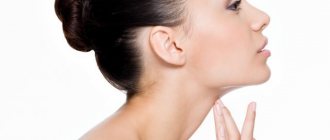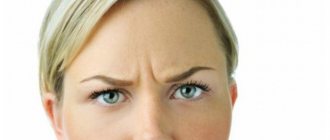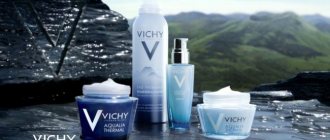What is uneven complexion
An uneven complexion can cause the following problems:
- age spots (pigmentation);
- spider veins (rosacea);
- rashes (acne, rosacea, seborrheic dermatitis);
- post-inflammatory spots;
- tired skin, “smoker’s skin”.
These signs can occur either individually or combined with each other, as, for example, in the case of photoaging of the skin. This problem is characterized by a “variegated” appearance due to numerous age spots, spider veins and skin atrophy.
Why do wrinkles appear on the forehead?
Skin aging is a natural process, and the appearance of deep wrinkles on the forehead with age is inevitable. But there are several factors that provoke the early appearance of wrinkles on the forehead:
- active facial expressions: for example, horizontal wrinkles appear when a person is often surprised and raises his eyebrows; vertical wrinkles and wrinkles on the forehead between the eyebrows occur when a person often frowns, moving the eyebrows towards the bridge of the nose.
- photoaging of the skin, under the influence of ultraviolet radiation the skin loses moisture faster,
- natural aging of the skin: with age, the production of natural collagen and elastin, which are responsible for skin elasticity, decreases;
- alcohol abuse and smoking: any bad habits negatively affect the skin and appearance in general.
Causes of uneven complexion
While the problem of dilated blood vessels and rashes may be genetically determined, one of the main causes of pigmentation is excessive sun exposure. Sunlight, namely the ultraviolet part of its spectrum, contributes to the appearance of pigmentation, dilated blood vessels and accelerated aging.
But it’s not just sunlight that causes skin changes: in some cases, it’s caused by excessive stress. For example, you fell asleep in the sun in the tropics, actively visited the solarium, or did a medium peel at the wrong time and in the wrong place.
Any injury instantly mobilizes skin resources: melanocytes are activated to produce melanin. This pigment acts as a protective shield, preventing potential skin breakdown. In addition, the body triggers the formation of new blood vessels in the skin to speed up metabolic processes, supply damaged skin with “building material” and remove destruction products.
An annoying problem can be a dull, sallow complexion, which is caused by impaired microcirculation as a result of spasm of the superficial vessels of the skin. This condition occurs due to a deficiency of vitamins, microelements, oxygen, sleep, as well as chronic exposure to nicotine.
Hyperkeratosis
A huge number of “dead cells” layered on the surface of the skin
The stratum corneum is a layer of cells (keratinocytes) on the surface of the skin - a “thin line” separating the body from the environment; beyond this line the outside world begins.
Normally, keratinocytes desquamate (exfoliate) from the surface of the skin on a constant basis, imperceptibly, without burdening or affecting the quality of life .
Hyperkeratosis - thickening of the stratum corneum , occurs due to excessive layering of keratinocytes (horny masses), and is a consequence of various skin conditions:
Untidy “unwashed” skin
Shine during the day, comedones, enlarged pores, inflammatory rashes (from single to numerous) are a consequence of hyperfunction of the sebaceous glands (excessive sebum secretion).
Keratinocytes are saturated with this secretion, sticking together, which leads to a deterioration in the desquamation process.
Essentially, in this case, an increased amount of “dead” cells, saturated with sebum, . Add to this wonderful composition the remnants of ineffectively removed makeup... More details
Hyperkeratosis shows age
The cells of the stratum corneum (keratinocytes) connect each other with desmosomes - special bridge structures that hold dead keratinized cells on the surface of the skin. Normally, when these connections are disrupted, the keratinocyte desquamates.
From the age of 30, the duration of stay of keratinocytes on the surface of the skin increases: every year by one day!
This occurs due to the strengthening of desmosomes. It becomes more difficult for keratinocytes to slough off and leave the surface of the skin. It’s hard to imagine that the life cycle of a skin cell depends so much on age :
- 30 years - average 28 days
- 40 years - 38 days,
- 50 years - 48 days,
- 60 years - 58 days...
This means that there are a huge number of dead cells on the surface of the skin that simply cannot leave the surface of the skin ! More details
Hyperkeratosis as a reaction to excess UV rays
Everyone has been in a situation where, after a long stay on the beach, the skin becomes dry and tight, flaking. ..
An increase in the thickness of the stratum corneum with excess UV rays is a protective reaction of the body that prevents the harmful effects of sunlight on the skin. The thickened stratum corneum, in this case, works on the principle of mechanical SPF .
Fortunately, the rehabilitation period after a beach holiday is temporary. In just a couple of professional procedures, a cosmetologist will be able to solve the problem of hyperkeratosis against the background of hyperinsolation.
However, for those who like to sunbathe excessively, photoaging will be a guaranteed attribute in the future.
The correct process of formation of horn cells (keratinization) ensures:
- The consistency of the skin barrier function (protection),
- Absence of skin diseases (psoriasis, atopic dermatitis, mycosis..)
- Aesthetic component (neat young skin with even texture).
DermaQuest - perfectly clean, smooth skin, radiating beauty and health!
Cosmetics
One of the most important methods for preventing and correcting skin imperfections is properly selected skin care. Calm active melanocytes, strengthen the vascular wall, accelerate the exfoliation of altered cells - this is the task of modern cosmetics.
Unfortunately, not every product can deliver active ingredients into the deep layers of the skin - it is important to choose products from the cosmeceutical group that actually work. The ideal solution could be the Australian cosmeceutical brand Ultraceuticals, recognized by cosmetologists around the world. In addition to skin care and treatment products, the line includes the world's best photoprotection products, without which it is impossible to imagine an even complexion and youthful skin.
Leather and its features
Human skin is a multifunctional organ, the condition of which is in close relationship with other organs and systems of the body. It has 3 layers, the thickness of which differs in different parts of the body. This:
- epidermis;
- dermis;
- subcutaneous fat tissue.
The epidermis is the top and thinnest layer of the skin. Moreover, it itself has a multilayer structure and is formed:
- stratum corneum;
- glassy or shiny layer (present only in the skin of the palms and soles);
- granular layer;
- spinous layer;
- basal layer.
The epidermis is 85% composed of keratinocytes - cells that contain keratin and successively undergo stages of differentiation, shifting from the basal layer to the spinous, granular and gradually losing water, the nucleus and turning into prismatic scales of the stratum corneum. The latter are called corneocytes. At the same time, the epidermis is constantly renewed due to the desquamation of corneocytes of the uppermost stratum corneum and its replacement by other keratinocytes, which also transform over time into corneocytes and are ultimately desquamated.
Thus, the skin is constantly renewed. If this process is disrupted due to the action of certain factors and desquamation slows down with thickening of the granular and stratum corneum of the skin or excessive formation of creatine is observed, hyperkeratosis develops.
External manifestations of problem skin
- pimples, blackheads
- furunculosis
- excessive skin greasiness
- unhealthy skin color, pallor
- excessive dry skin
- "spider veins"
- itchy skin
- yellowness of the skin
- dark spots
- allergic skin reactions
- fungal infections, candidiasis
- sagging skin
- early wrinkles
Depending on age, general condition and health of the body, skin type and many other reasons, skin problems can be temporary and quickly passing, or they can cause serious distress. If the skin of the face consists of dry, normal and oily areas, it is called combination. This skin type is especially common in women. The T-zone of the face (forehead, nose, chin) is covered with oily skin. The skin around the eyes, cheeks and neck is normal or dry. Oily skin and dry sensitive skin represent the most problematic types.
Brunettes and young girls and women most often have oily skin. Unlike other types, oily skin is not at risk of developing premature wrinkles. But she has other serious problems. Oily skin is distinguished by a greasy sheen, large pores, a yellowish olive color, and poor blood circulation. Oily skin is fraught with acne and oily seborrhea, especially during puberty as a result of hormonal changes in the body.
Dry skin lacks natural protection in the form of sebum, which is produced in insufficient quantities in this type. This is why dry skin looks like it does – dry and flaky. Dry skin is susceptible to external factors: unfavorable climatic and weather conditions, mechanical influences (rough clothing or contact with a man’s beard). The result of such effects is skin irritation, redness and rash. Dry skin does not tolerate bad water; After washing, there is discomfort and a feeling of skin tightness. Dry skin is very “picky” regarding cosmetic products; certain components included in their composition can provoke undesirable consequences.
Evening out facial skin tone using cosmetics
Perfect eyeliner, perfectly formed eyebrows, velvety eyelashes and sensual lips will not look beautiful without evening out your skin tone. Makeup, even the most spectacular, will lose all meaning if you do not give the desired shade to the skin and hide inflammation and bruises under the eyes.
And, on the contrary, an ideal complexion, smooth, without signs of fatigue, will allow you to look amazing even with barely noticeable makeup - only tinted eyelashes and gloss applied to the lips. Nude makeup, popular in recent years, is not losing its position and is often used in the images of models at all kinds of fashion shows. By evening out the skin tone of the participants, make-up artists achieve a flawless complexion, the girls’ skin becomes velvety, as if it is glowing from within.
Recommended articles on the topic:
- Ultrasonic facial peeling is a pleasant and beneficial procedure for your skin
- Redermalization of the skin: all the pros and cons
- Almond peeling for the face: features of the procedure
A competent selection of cosmetics suitable for your skin type allows you to make high-quality makeup in accordance with your style.
- Makeup base (primer). To even out the texture of the dermis and moisturize it a little, apply a primer before using foundation - thanks to it, the tone lies more evenly and traces of peeling become invisible. The primer often includes some kind of pigment (yellow, pink, lilac, green), which allows you to mask local problems that worsen your complexion.
So, for skin with a predominant red-pink tint, a primer with green pigment is intended (eliminates excessive redness and gives naturalness). Lilac color brightens the skin and makes it radiant. The pink color of the makeup base helps get rid of the olive tint, and the yellow color helps to get rid of bluishness and pallor of the skin. The primer not only moisturizes the skin, but also adds matteness.
- Foundation. It's hard to imagine evening out your skin tone without foundation. To select the most suitable shade and texture, a little product is first applied to the skin and assessed according to various parameters. The foundation should perfectly match the natural tone; you cannot choose a darker or lighter option. Such a base can be compared to a canvas: just as a drawing gradually appears on it, makeup is created on the face with foundation applied (eyeliner, eye shadow, blush, lipstick, etc.).
- BB cream or CC cream to even out skin tone. With the advent of these cosmetics on the market, ideas about the possibilities of makeup have changed greatly. The secret to the popularity of BB cream or CC cream is its excellent price-quality ratio and amazing effect: these products provide the skin with an even tone, excellent care (moisturizes and protects against harmful influences) and a beautiful appearance. Moreover, the price of the creams is quite affordable, and they are applied easily and quickly.
Compared to foundation, these creams have a lighter texture; they lie in a thin layer and are invisible on the face and neck. And the CC cream (an improved formula of the BB cream) has an almost weightless texture, and also has a mattifying effect. For those with oily skin, this is an excellent option for evening out tone. Manufacturers of BB creams and CC creams are constantly working to improve their characteristics: they include components with antioxidant properties and a rejuvenating effect.
- Highlighter to add radiance to the face. This cosmetic product, used before applying makeup, helps to highlight individual areas, thereby highlighting them from others. Highlighter is used on the cheekbones, bridge of the nose, middle part of the forehead, along the border of the skin and upper lip, on the moving eyelid, often in combination with bronzer or dark powder. The texture of the product can be creamy, liquid, or powdery.
To even out your skin tone at home, highlighter can be applied as a base for foundation, or you can mix them. In any case, the skin will not only look smooth, but also acquire a slight pearlescent glow. The product is used under the foundation when creating daytime makeup, but if you need to create an evening look, first apply foundation or powder with a mattifying effect to the face and only then apply highlighter.
- Concealer and corrector to eliminate local imperfections. Foundation cannot completely mask redness on the face or dark circles under the eyes - you need special products that also have a moisturizing effect. A green corrector is used to neutralize redness, and a reddish-pink one is used to eliminate bruises.
Correctors and concealers are not applied in a continuous layer over the entire face - only pointwise to problem areas. The texture of these products can be different: either light liquid or dense creamy. Liquid correctors create tone, and thicker matte ones also smooth out unevenness. With their help, it is easy to make pigment spots and inflammation on the skin invisible.
To fix the corrective product on the skin, powder it a little.
- Shimmer (from the English shimmer - flicker). This cosmetic product is used to even out skin tone and eliminate dullness with a shimmering effect. Shimmer is similar to highlighter, but it contains components that provide multifaceted radiance (mica, mother-of-pearl, minerals), while highlighter gives a different effect. Using a shimmer with a powdery texture is the easiest way to give your evening look the final shine. To apply the product, a special brush with artificial bristles is required.
- Powder . Without this cosmetic product, your makeup will be incomplete. Powder helps fix the final result and keep the makeup longer. It is allowed to apply powder directly to the face, and not to foundation. There are different types of powder for different skin types. For example, its antibacterial composition is ideal for problem skin, and powder with the lightest finish is ideal for dryness and flaking.











